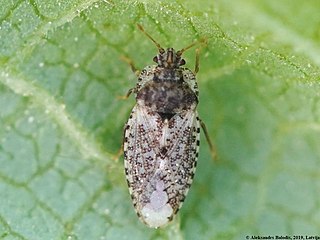
Chaeteessidae is a family of praying mantises. It contains a single extant genus, Chaeteessa, native to South America which is thought to be the most primitive and earliest diverging lineage of living mantises. Fossil genera are known from the Paleogene of Eurasia and North America.

Rhachiberothidae, sometimes called thorny lacewings, are a family of winged insects in the order Neuroptera. The family has only 14 extant species in 4 genera found in Sub-Saharan Africa, but has a diverse fossil record extending back to the Early Cretaceous in Lebanon, Eurasia and North America. Like the closely related Mantispidae members of the group possess raptorial forelegs, which probably only evolved once in the common ancestor of the groups.

Sisyridae, commonly known as spongeflies or spongillaflies, are a family of winged insects in the order Neuroptera. There are approximately 60 living species described, and several extinct species identified from the fossil record.

Piesmatidae is a small family of true bugs, commonly called ash-grey leaf bugs. The Piesmatidae are distributed mostly in the temperate Northern Hemisphere, with some occurring in Africa, Australia and South America. A common species found throughout the Americas is Piesma cinereum.

Cupes is a genus of beetles in the family Cupedidae. The Cupedidae are typical “reticulate” or “net-winged” beetles with incompletely sclerotized elytra that produce the characteristic reticulate appearance.

Salpingidae or narrow-waisted bark beetles is a family of beetles in the superfamily Tenebrionoidea. The species are small, about 1.5 – 7 mm in length. The family is globally distributed and consists of about 45 genera and 300 species, which are generally found in the temperate regions of both hemispheres. The family is mainly associated with plants as well as with ascomycete and hyphomycete fungi. Some members of the family are associated with unusual habitats, like Aegialites and Antarcticodomus, which are found in coastal areas including the intertidal zone, with former feeding on algae.

Ordralfabetix is an extinct genus of planthoppers in the family Lophopidae and containing the single species Ordralfabetix sirophatanis. The species is known only from the Early Eocene, Ypresian stage Oise amber from the Quesnoy locality, Oise Department, France.
The Argiles d'lignite du Soissonnais is a geologic formation in the Oise department of northern France. The formation has provided fossil mammals, reptiles and fish as well as arthropods in the amber of the formation. The Argiles d'lignite du Soissonnais dates back to the Ypresian stage of the Eocene period.

Melittidae is a small bee family, with over 200 described species in three subfamilies. The family has a limited distribution, with all described species restricted to Africa and the northern temperate zone.

Embolemidae is a family of small solitary parasitoid wasps with around 70 species in 2 genera distributed around the world. The few species whose biology is known are parasites on planthopper nymphs of the families Achilidae and Cixiidae. There is debate regarding the status of the genus named Ampulicomorpha by Ashmead in 1893, generally considered now to be a junior synonym of Embolemus (e.g.,), though some authorities dispute this (e.g.,)
Acolaspoides is an extinct genus of leaf beetles in the subfamily Eumolpinae. It contains only one species, Acolaspoides longipes, and is known only from lowermost Eocene amber collected from Le Quesnoy, Oise Department, France.
Aoriopsis is an extinct genus of leaf beetles in the subfamily Eumolpinae. It contains only one species, Aoriopsis eocenicus, and is known only from lowermost Eocene amber collected from Le Quesnoy, Oise Department, France.

Thaumastocoridae is a family of true bugs in the order Hemiptera. There are about 9 genera and more than 20 described species in the family Thaumastocoridae.

Winnertziinae is a subfamily of gall midges and wood midges in the family Cecidomyiidae.
Microphorites is an extinct genus of flies in the family Dolichopodidae.
Electrentomidae is an extinct family of barklice, booklice, and parasitic lice in the order Psocodea. There are about six genera and seven described species in Electrentomidae. The family was synonymsed with the extant family Manicapsocidae in 2003 without discussion, with a prior proposal in 1972, but Azar et al., 2017, stated that "we consider herein [Electrentomidae and Manicapsocidae] apart, because a cladistic phylogenetic analysis is needed prior to taking such important decision for these groups."
Manicapsocidae is a family of Psocodea. It contains 8 extant species in 4 genera, with most of the species being found in the Neotropics and one species in the Afrotropics. The extinct family Electrentomidae has been suggested as a synonym of this family, though this has been considered premature by other scholars in the absence of cladistic analysis. Confirmed fossil species of the family are nearly as numerous as living ones, extending back to the mid-Cretaceous.
Empheriidae is an extinct family of Psocoptera in the suborder Trogiomorpha.

Oise amber is a type of amber found near the Oise river near Creil in northern France. Oise amber is around 53 million years old, dating to the Early Eocene (Ypresian). Oise amber is softer than Baltic amber, although Oise amber is older and both types of amber have similar geographic origins. The formation is known for preserving a diverse fauna of invertebrates.











